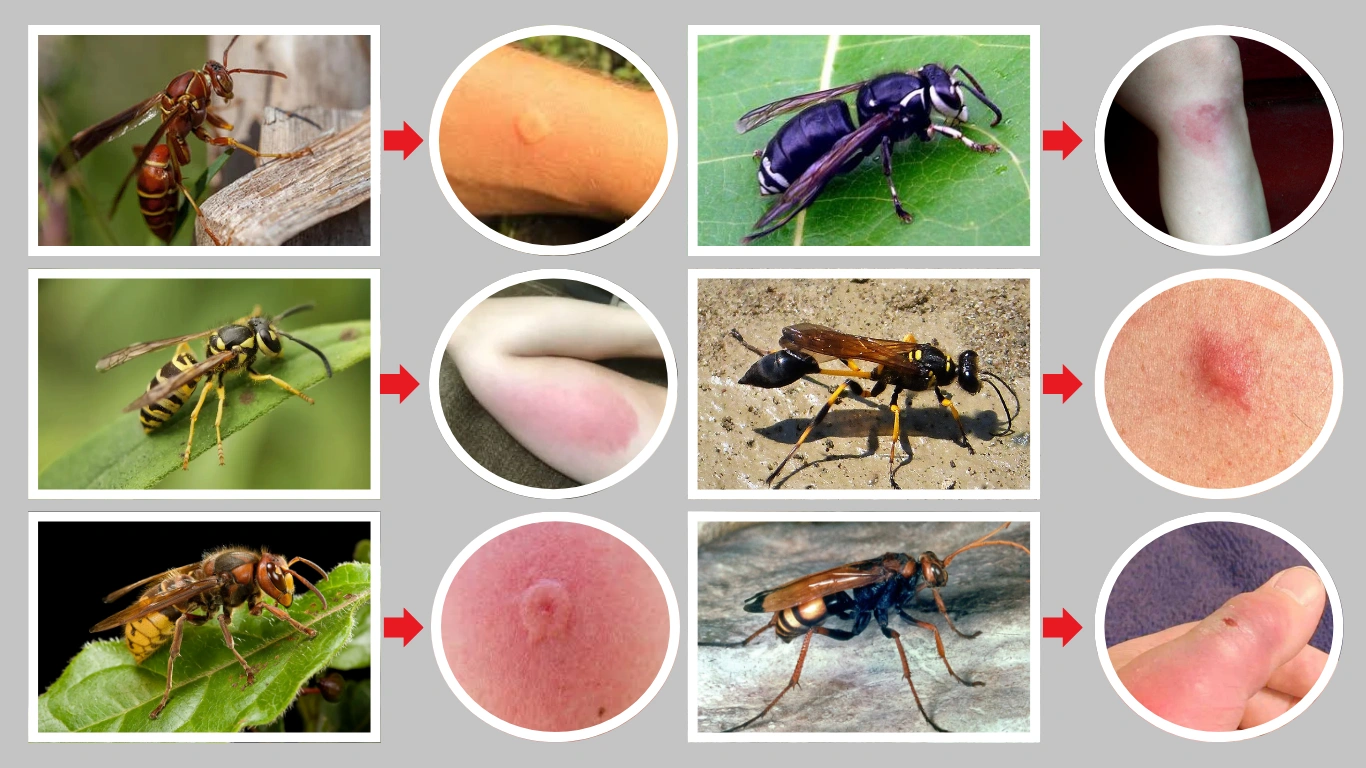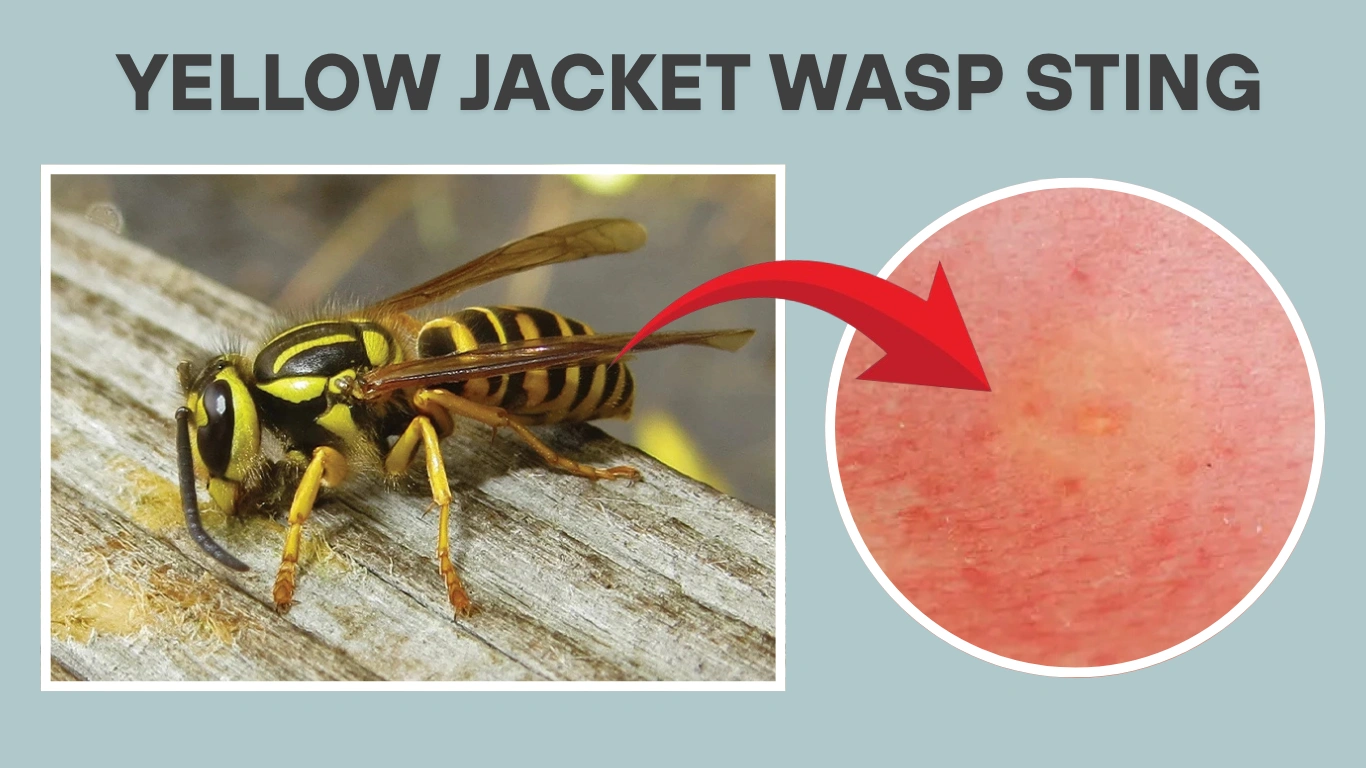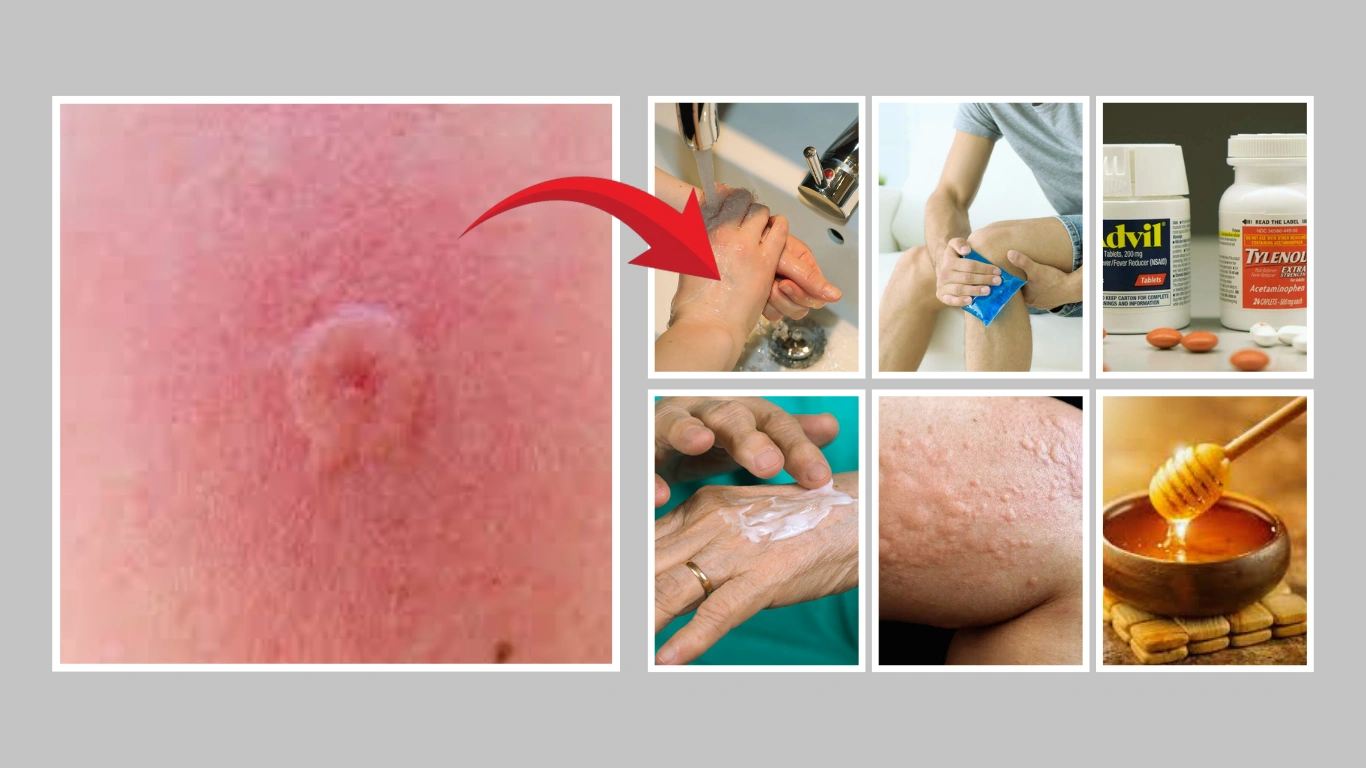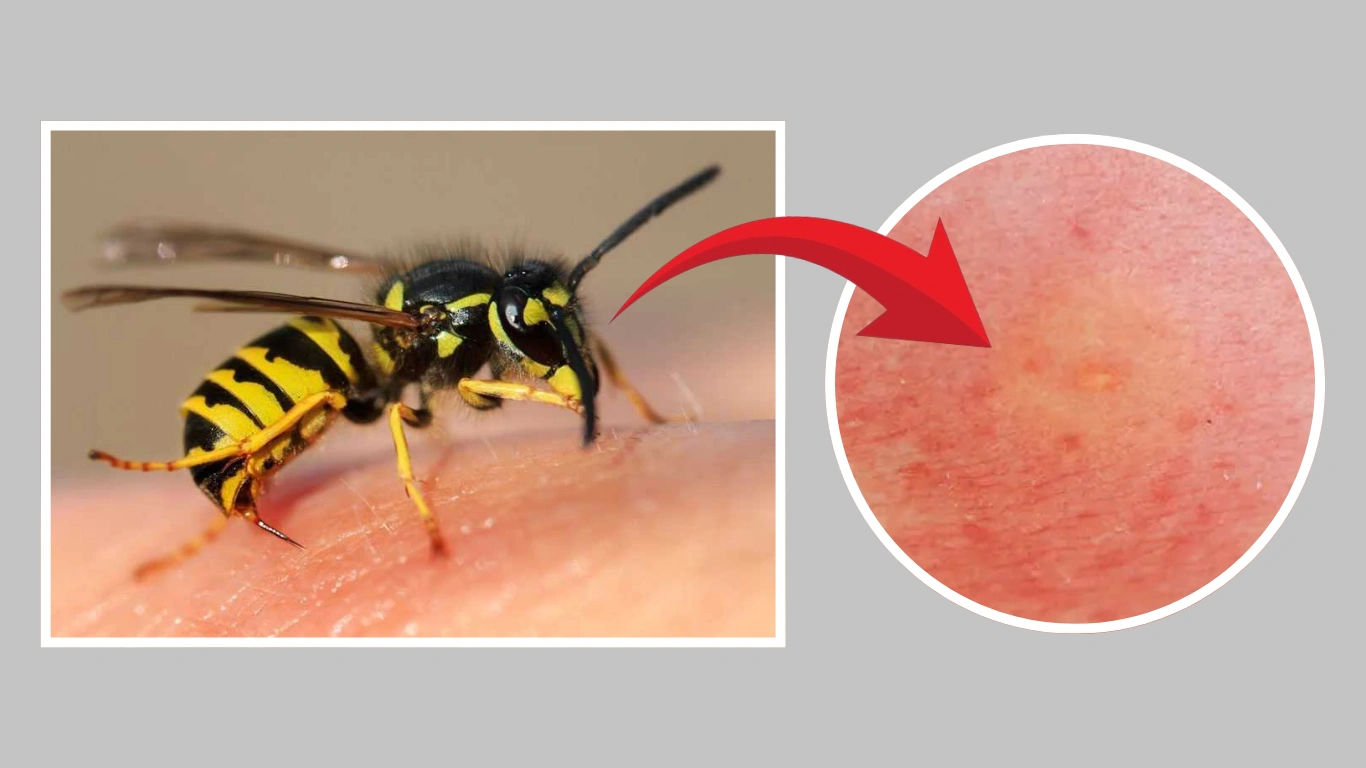Wasp stings can range from mildly annoying to intensely painful—and knowing what stung you makes a big difference. In this guide, I’ll break down 15 different types of wasp stings based on real experience and research. You’ll learn how to identify each sting, what symptoms to expect, and how to treat them properly. Whether you’re outdoors often or just curious, this will help you stay prepared.
1. Paper Wasp Sting
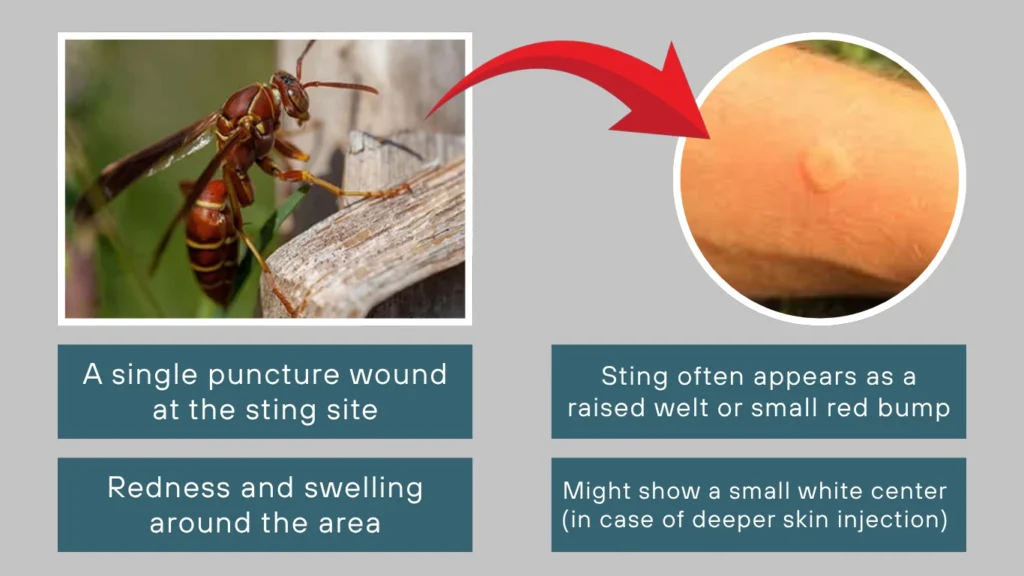
Paper wasps are among the most commonly encountered wasps in gardens and around homes. Though generally non-aggressive, they will sting when threatened, and their sting can cause moderate pain, swelling, and allergic reactions in sensitive individuals.
Identification of Sting
- A single puncture wound at the sting site
- Redness and swelling around the area
- Sting often appears as a raised welt or small red bump
- Might show a small white center (in case of deeper skin injection)
- Typically occurs on exposed skin like arms, neck, or hands
Common Symptoms
The sting usually causes immediate pain with a burning sensation. Swelling, redness, and itching follow. Some people might experience warmth at the sting site and localized skin sensitivity for hours. In more sensitive individuals, symptoms can include nausea, dizziness, or even mild breathing difficulty.
Treatment Methods
Quickly clean the sting area with soap and water to prevent infection. Apply a cold compress to reduce swelling and ease pain. Over-the-counter pain relievers or antihistamines like ibuprofen or diphenhydramine (Benadryl) can help manage discomfort and itching. Avoid scratching to reduce the risk of infection.
How Long It Lasts
The pain from a paper wasp sting generally fades within a few hours, while swelling and redness may last 1–3 days. In rare allergic cases, symptoms may persist longer and require medical care.
When to Seek Medical Help
If you experience shortness of breath, severe swelling beyond the sting area, hives, rapid heartbeat, or trouble swallowing, seek emergency medical attention immediately. These could be signs of an allergic reaction or anaphylaxis.
2. Yellow Jacket Sting
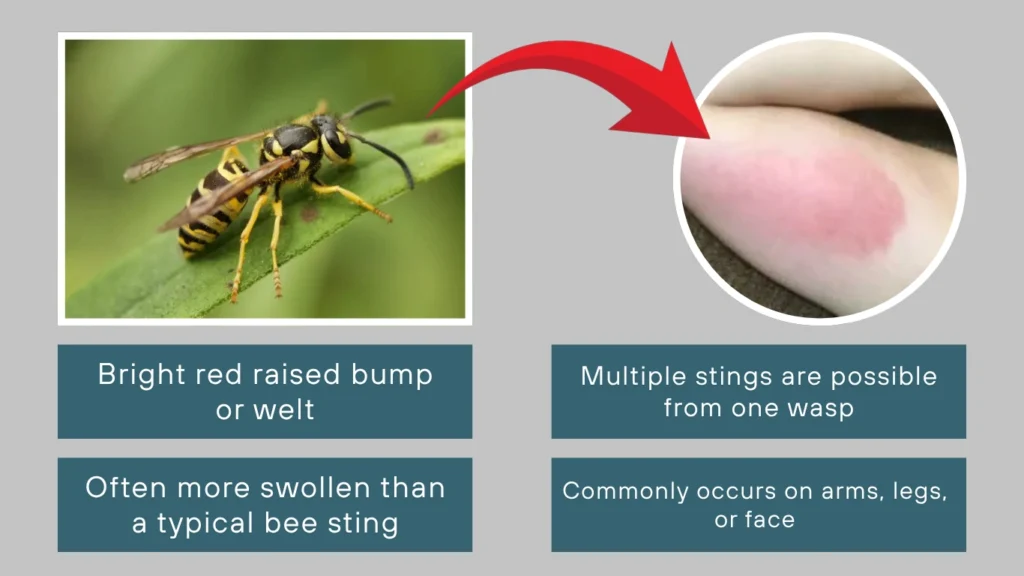
Yellow jackets are aggressive wasps commonly found scavenging around food and garbage. Their stings are painful and often involve repeated attacks, as they can sting multiple times.
Identification of Sting
- Bright red raised bump or welt
- Often more swollen than a typical bee sting
- Multiple stings are possible from one wasp
- Commonly occurs on arms, legs, or face
- Sting site may appear bruised or show white at the center
Common Symptoms
Stings cause sharp, burning pain followed by itching, redness, and localized swelling. In sensitive individuals, symptoms may escalate to hives, wheezing, or vomiting. Pain can be intense for several hours.
Treatment Methods
Wash the area with soap and water, then apply a cold compress. Take antihistamines to reduce allergic response and pain relievers for swelling or discomfort. Topical hydrocortisone cream may ease itching.
How Long It Lasts
Pain may subside in a few hours, but swelling and itching can persist for 2–3 days. Repeated stings or allergic reactions may extend recovery time.
When to Seek Medical Help
Seek medical care if you develop facial swelling, throat tightness, difficulty breathing, or fainting. Yellow jackets are a common cause of anaphylaxis in wasp sting victims.
3. Hornet Sting (European Hornet)

The European hornet is one of the largest wasp species in North America. Its sting delivers a large dose of venom, which can cause more intense pain and reactions.
Identification of Sting
- Noticeable red bump with a small puncture hole
- Rapid swelling around the site
- Possible bruising or a burning halo around the sting
- Often stings occur on the upper body, head, or neck
- The sting may feel hot or numb initially
Common Symptoms
Symptoms include immediate, burning pain, followed by swelling and redness. Some individuals report tingling or numbness near the sting. Nausea or headache may follow in severe cases.
Treatment Methods
Clean the site with antiseptic or soap and water. Use an ice pack to control swelling. Painkillers and antihistamines are effective for symptom control. Keep the area elevated if possible.
How Long It Lasts
Pain can linger for 4–6 hours. Swelling and redness may take up to a week to fully resolve, especially in those with mild allergic reactions.
When to Seek Medical Help
Medical attention is necessary if multiple stings occur, or if symptoms escalate to chest tightness, hives, or dizziness. Hornet venom is more potent than other wasps and can trigger severe reactions.
4. Bald-Faced Hornet Sting
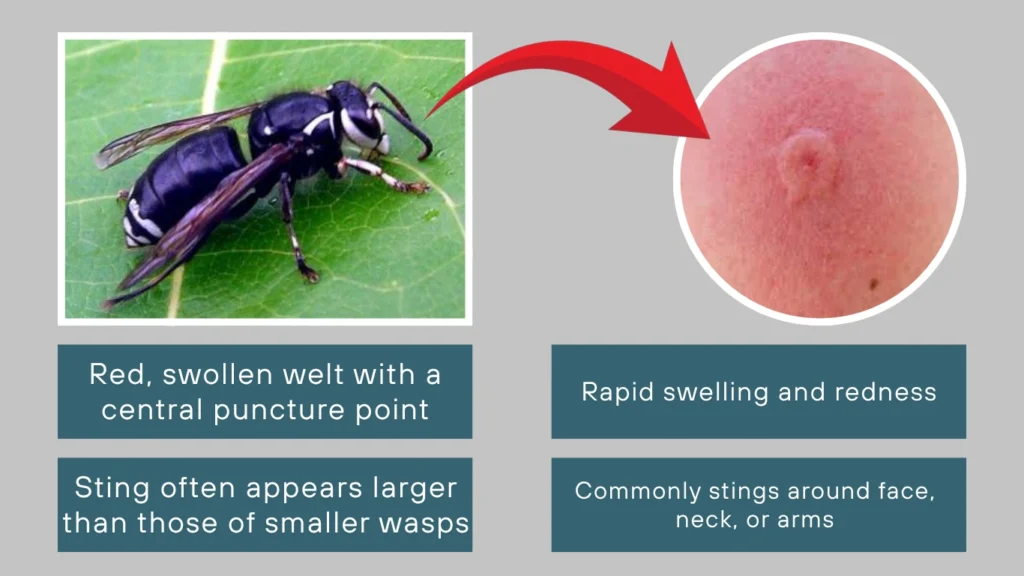
Bald-faced hornets are technically a type of yellow jacket but are larger and more aggressive, especially when defending their nests. Their sting is potent and painful.
Identification of Sting
- Red, swollen welt with a central puncture point
- Sting often appears larger than those of smaller wasps
- Rapid swelling and redness
- Commonly stings around face, neck, or arms
- Sometimes followed by a slight bruise-like appearance
Common Symptoms
Immediate, sharp pain is followed by a burning sensation and visible swelling. Itching and tenderness can develop shortly after. Some people may also experience fatigue or mild fever symptoms after a sting.
Treatment Methods
Apply cold compresses immediately and cleanse with soap and water. Use hydrocortisone cream for itching and antihistamines to reduce allergic reactions. Pain relievers like acetaminophen or ibuprofen can help reduce discomfort.
How Long It Lasts
Pain usually diminishes in a few hours, but swelling and itching may last 2–4 days. Severe reactions could prolong healing time.
When to Seek Medical Help
Seek medical attention for stings near the eyes or throat, or if you experience swelling beyond the sting site, trouble breathing, or a systemic reaction such as dizziness or vomiting.
5. Mud Dauber Wasp Sting
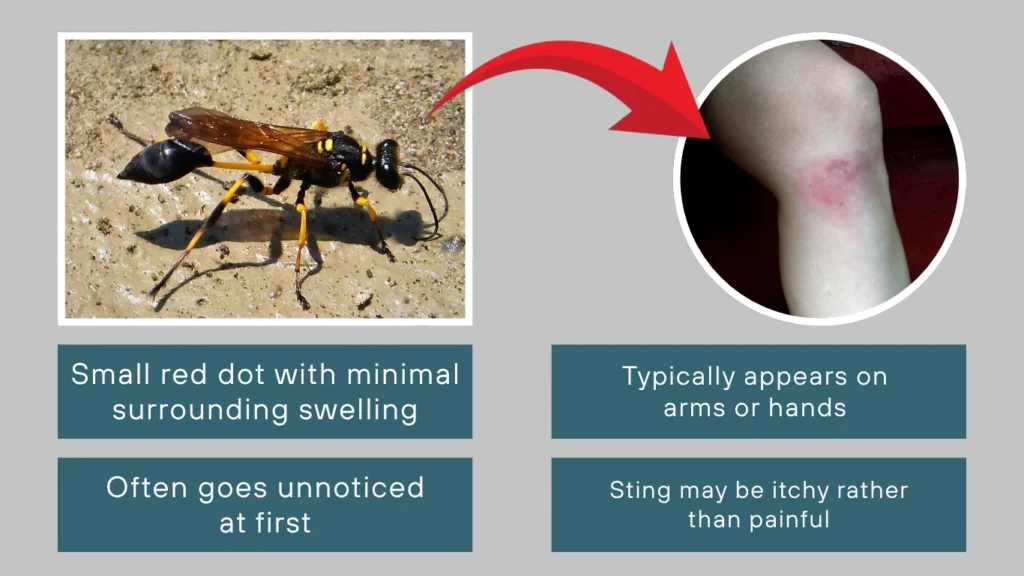
Mud daubers are solitary wasps and rarely sting unless directly handled or trapped. Their sting is less painful compared to social wasps.
Identification of Sting
- Small red dot with minimal surrounding swelling
- Often goes unnoticed at first
- Typically appears on arms or hands
- Sting may be itchy rather than painful
- No major visible reaction in most individuals
Common Symptoms
Most stings are mild with little pain. It may cause brief stinging followed by minor itching. Rarely, people report localized swelling or redness.
Treatment Methods
Rinse the area with soap and water. Apply a cold compress to prevent swelling. If itching occurs, use calamine lotion or an antihistamine cream.
How Long It Lasts
Symptoms usually disappear within a few hours. In some cases, slight irritation may linger for a day.
When to Seek Medical Help
Though reactions are rare, seek help if there’s any difficulty breathing, spreading rash, or if multiple stings occur.
6. Cicada Killer Wasp Sting

Cicada killers are large, solitary wasps that look intimidating but are generally non-aggressive. They rarely sting humans unless provoked or handled.
Identification of Sting
- Small, pinpoint red mark with very mild swelling
- Less inflamed compared to other wasp stings
- Often seen on hands or arms when accidentally disturbed
- Usually just a single sting site
- Minimal to no surrounding redness
Common Symptoms
The sting causes a mild, brief pain, often described as a pinch. Most people experience no major swelling or discomfort. Sensitive individuals may feel a bit of localized irritation or itchiness.
Treatment Methods
Clean the sting area with soap and water. Apply a cold compress if there’s slight swelling. Over-the-counter creams can be used if mild itching occurs.
How Long It Lasts
Pain and any mild symptoms usually fade within 1–2 hours. No long-lasting effects are typical unless an allergic reaction occurs.
When to Seek Medical Help
Though rare, allergic reactions like hives or shortness of breath require immediate attention. This is more likely in individuals with a history of insect sting allergies.
7. Tarantula Hawk Wasp Sting
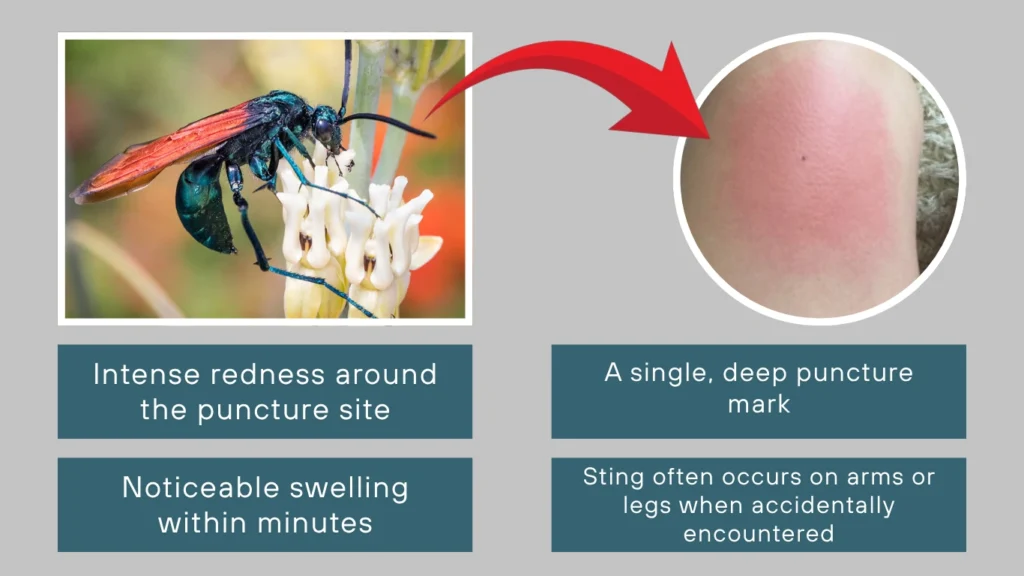
Known for delivering one of the most painful insect stings in the world, the tarantula hawk is a large wasp found in desert regions. Despite its powerful sting, it is not aggressive toward humans.
Identification of Sting
- Intense redness around the puncture site
- Noticeable swelling within minutes
- A single, deep puncture mark
- Sting often occurs on arms or legs when accidentally encountered
- No bruising but may develop a firm red area around the sting
Common Symptoms
The sting causes immediate, excruciating pain, often described as electric or paralyzing. The intense pain typically subsides after 5–10 minutes but leaves soreness, redness, and localized heat for hours.
Treatment Methods
Remain calm and still after a sting. Clean the area thoroughly, then apply a cold pack. Pain relievers and antihistamines may be used, though the initial pain typically resolves on its own. Avoid scratching to prevent irritation.
How Long It Lasts
The severe pain fades in less than 30 minutes, but redness, soreness, and mild swelling can last up to 2–3 days.
When to Seek Medical Help
Seek medical help if you experience unusual swelling, nausea, or allergic reactions. While not fatal, this sting can be overwhelming and may require monitoring for individuals with low pain tolerance or sensitivity.
8. Red Paper Wasp Sting
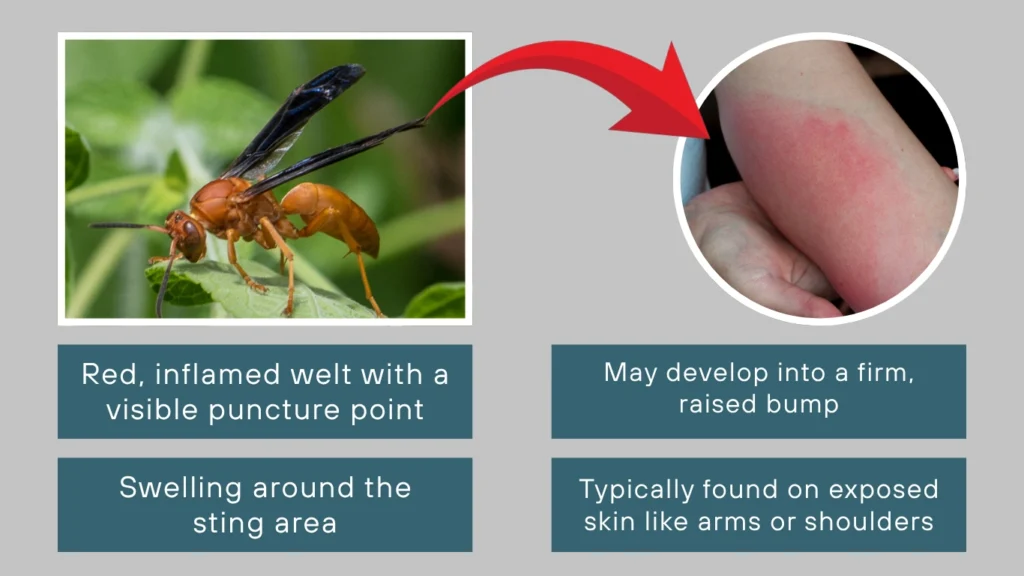
Red paper wasps are a subspecies of paper wasps known for their reddish-brown color and potent stings. They can be aggressive if disturbed and sting repeatedly.
Identification of Sting
- Red, inflamed welt with a visible puncture point
- Swelling around the sting area
- May develop into a firm, raised bump
- Typically found on exposed skin like arms or shoulders
- Sometimes a clear fluid blister may appear
Common Symptoms
Their sting causes immediate, sharp pain followed by localized swelling, redness, and burning. Itching may develop later, and sensitive individuals might feel dizziness or nausea.
Treatment Methods
Rinse the area gently with soap and water. Use an ice pack to reduce swelling and inflammation. Apply antihistamines or topical hydrocortisone for itch relief. Painkillers may be used for comfort.
How Long It Lasts
Pain generally fades in a few hours, but swelling and redness may last 1–3 days depending on sensitivity.
When to Seek Medical Help
Immediate medical attention is needed if you experience facial swelling, throat tightness, or signs of a severe allergic reaction. Multiple stings may also require observation.
9. Potter Wasp Sting
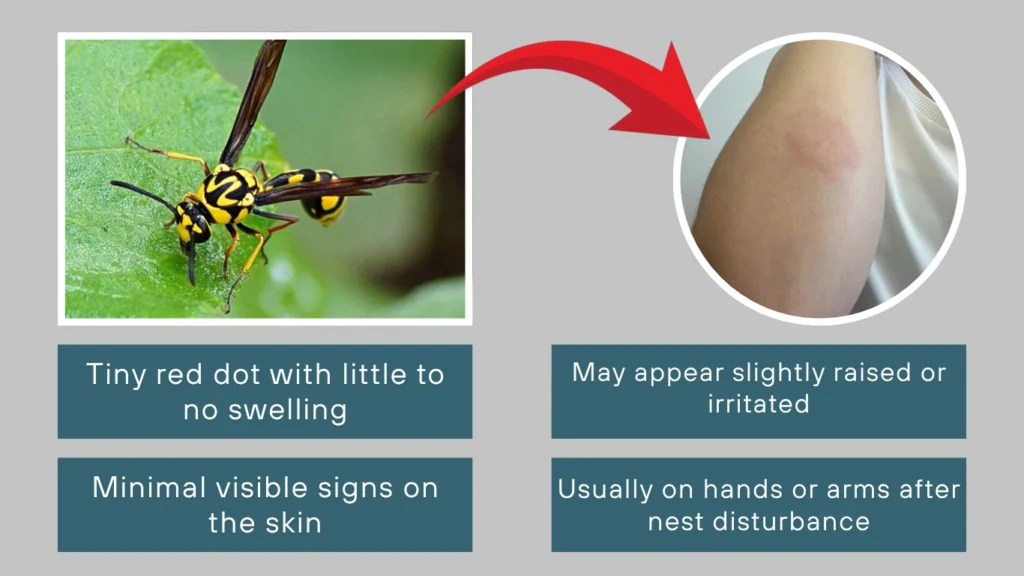
Potter wasps are solitary wasps known for building small clay-like nests. They are not aggressive, and their sting is mild, often mistaken for a minor insect bite.
Identification of Sting
- Tiny red dot with little to no swelling
- Minimal visible signs on the skin
- May appear slightly raised or irritated
- Usually on hands or arms after nest disturbance
- No bleeding or bruising
Common Symptoms
Pain is usually mild, lasting only a few minutes. Itching or tenderness may follow. Most individuals do not react strongly unless they have insect sting sensitivity.
Treatment Methods
Clean the sting site and apply a cold compress. Use a mild topical antihistamine cream if any itchiness occurs. Oral antihistamines are rarely needed.
How Long It Lasts
Discomfort usually disappears within an hour. Minor redness may linger for a day but resolves quickly without complications.
When to Seek Medical Help
Seek help if you notice signs of an allergic reaction such as hives, trouble breathing, or swelling beyond the sting area, although such cases are very rare with potter wasps.
10. Warrior Wasp Sting
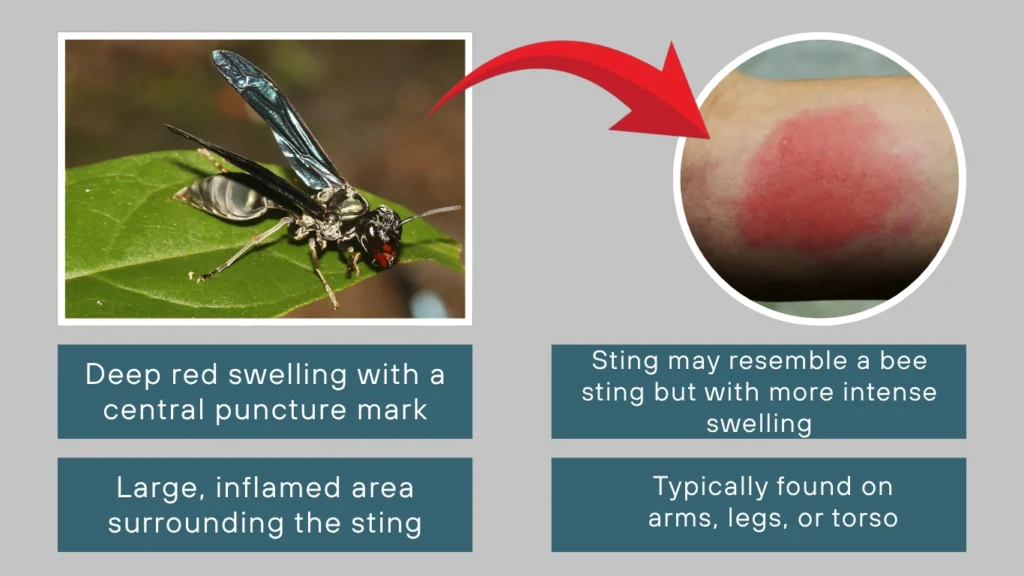
Warrior wasps are among the most feared for their sting, which is extremely painful and used as a defense mechanism. These wasps are native to Central and South America and known for their aggressive behavior.
Identification of Sting
- Deep red swelling with a central puncture mark
- Large, inflamed area surrounding the sting
- Sting may resemble a bee sting but with more intense swelling
- Typically found on arms, legs, or torso
- In some cases, mild bruising may develop
Common Symptoms
The sting causes immediate and severe pain, often described as burning or throbbing. It may lead to dizziness, sweating, and nausea in highly sensitive individuals. Skin around the sting often becomes hard and hot to the touch.
Treatment Methods
Immediately clean the sting site and apply a cold compress. Take pain relievers like ibuprofen and antihistamines for swelling and discomfort. Avoid physical activity for several hours after a sting to reduce systemic spread of venom.
How Long It Lasts
Severe pain usually lasts for 30 minutes to 1 hour, with swelling and irritation lingering up to 3–5 days. In some cases, the skin remains tender even after visible symptoms fade.
When to Seek Medical Help
Due to the intense nature of the sting, it’s advisable to consult a doctor if symptoms worsen or if you experience confusion, difficulty breathing, or rapid heartbeat.
11. Blue Mud Dauber Sting
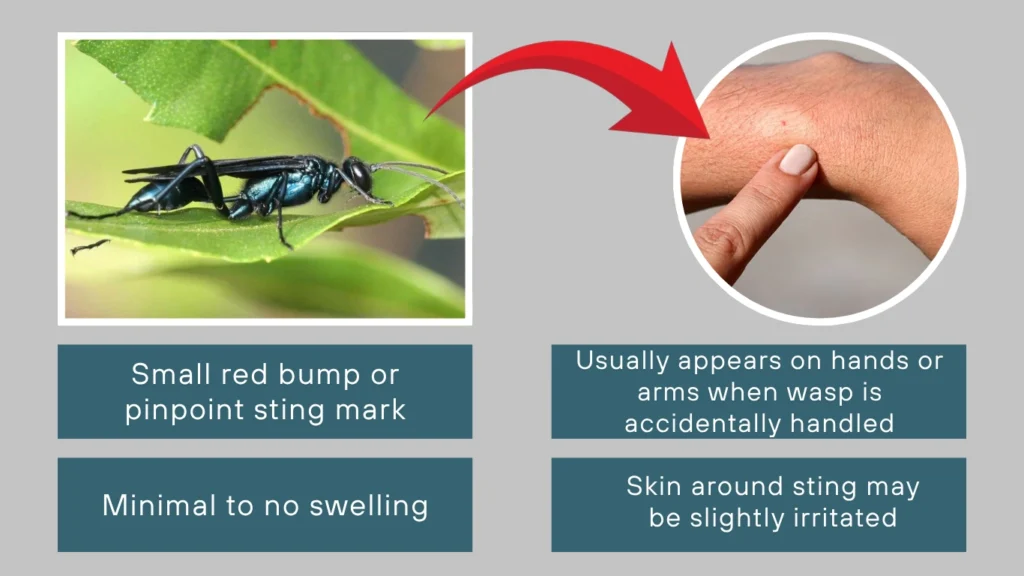
Blue mud daubers are solitary wasps known for their striking metallic blue color. They rarely sting, and when they do, the effects are usually mild.
Identification of Sting
- Small red bump or pinpoint sting mark
- Minimal to no swelling
- Usually appears on hands or arms when wasp is accidentally handled
- Skin around sting may be slightly irritated
- No bruising or major discoloration
Common Symptoms
The sting causes a sharp pinch or prickling sensation, followed by slight tenderness. Most people report no lingering discomfort. Minor itching or tingling may occur.
Treatment Methods
Wash the sting site with soap and water. A cold compress can soothe any irritation. Antihistamines or calamine lotion may help if itching develops.
How Long It Lasts
Symptoms are very short-lived—most fade within an hour. In rare cases, a mild reaction may last up to a day.
When to Seek Medical Help
Medical attention is rarely needed unless the person has a known allergy to wasp venom or shows unexpected symptoms like rash, swelling, or trouble breathing.
12. Great Golden Digger Wasp Sting
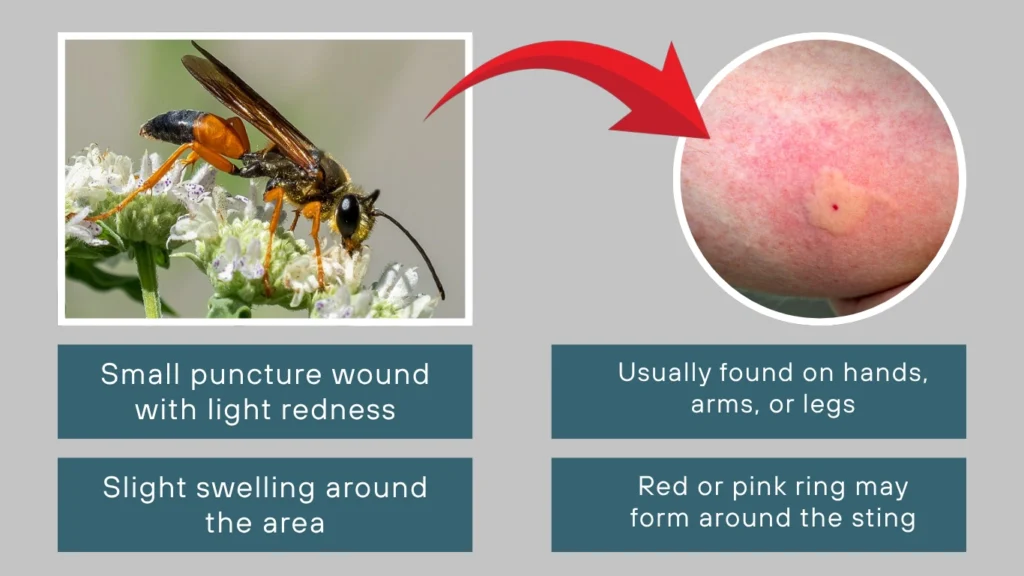
The Great Golden Digger Wasp is a large, solitary wasp with a striking orange and black body. Though it looks intimidating, it is docile and stings only when severely provoked.
Identification of Sting
- Small puncture wound with light redness
- Slight swelling around the area
- Usually found on hands, arms, or legs
- Red or pink ring may form around the sting
- Rarely causes any visible welt or bruise
Common Symptoms
Pain from the sting is mild and short-lasting. Some people may experience a tingling or burning sensation, followed by temporary redness or itching. Severe reactions are uncommon.
Treatment Methods
Clean the sting site thoroughly. Apply ice to minimize swelling. Use topical creams if itching develops. Antihistamines may help those who have mild allergic reactions.
How Long It Lasts
Pain usually fades within 15–30 minutes, and redness or irritation may last a few hours. No long-term effects are expected in most individuals.
When to Seek Medical Help
Though stings are typically harmless, seek medical attention if swelling spreads, or if breathing difficulties, dizziness, or other allergic symptoms develop.
13. Velvet Ant Sting (Cow Killer Wasp)

Despite being called an “ant,” the velvet ant is actually a flightless female wasp with an extremely painful sting. It’s often nicknamed the “cow killer” because of the intense pain it causes.
Identification of Sting
- Prominent red bump at the sting site
- Immediate and intense redness
- Often a single sting with a hard central point
- Found on feet or ankles when accidentally stepped on
- Area may feel warm and tight after the sting
Common Symptoms
The sting causes sharp, burning pain that can last several minutes. Redness and tenderness follow, often with throbbing or localized heat. Some people may develop a rash or hives around the sting site.
Treatment Methods
Wash the area thoroughly with soap and water. Apply a cold compress and take anti-inflammatory medications. Use hydrocortisone cream or antihistamines to reduce swelling and itching.
How Long It Lasts
Severe pain typically lasts 30 minutes to 1 hour. Redness and sensitivity may remain for 2–3 days. Mild reactions can extend the healing period slightly.
When to Seek Medical Help
Immediate help is necessary if symptoms escalate to dizziness, trouble breathing, or if stung multiple times. While not lethal, the sting’s intensity can be overwhelming, especially for children or allergic individuals.
14. Ichneumon Wasp Sting
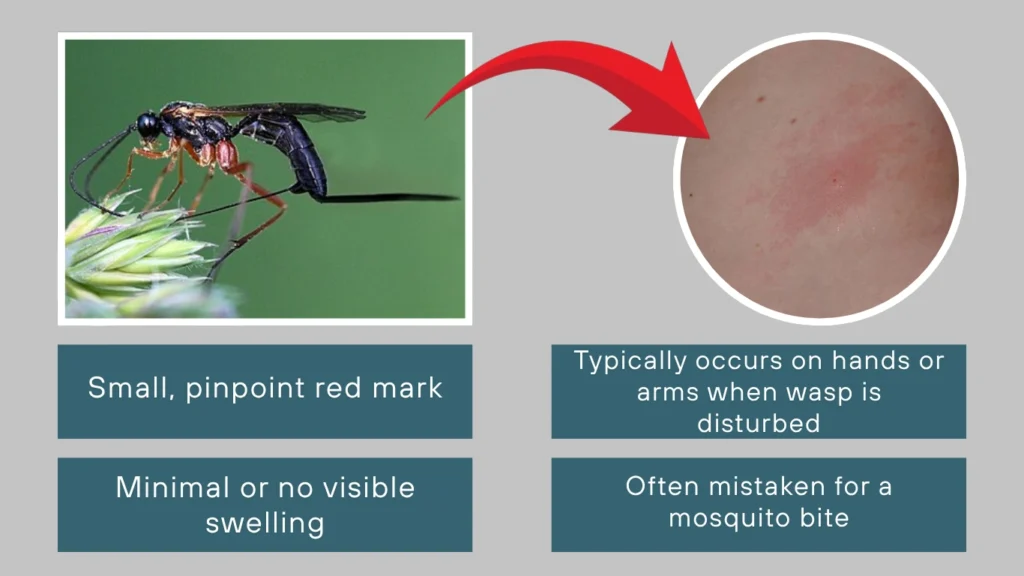
Ichneumon wasps are a large group of parasitic wasps with long, slender bodies and sometimes very long ovipositors. Most species do not sting humans, but a few can if threatened.
Identification of Sting
- Small, pinpoint red mark
- Minimal or no visible swelling
- Typically occurs on hands or arms when wasp is disturbed
- Often mistaken for a mosquito bite
- No central bruise or blister
Common Symptoms
Pain is mild and often described as a quick prick. Some people may not feel it at all. Occasionally, there may be light itching or tenderness afterward. Serious symptoms are extremely rare.
Treatment Methods
Wash the area gently. Apply a cold compress to soothe irritation. Most stings don’t require medication, but you may use a mild antihistamine if any itching develops.
How Long It Lasts
Any discomfort fades within minutes to an hour. Slight redness may persist for a few hours at most.
When to Seek Medical Help
It’s rare, but allergic individuals should monitor for swelling, rash, or breathing difficulty. Otherwise, no medical attention is typically required for an ichneumon wasp sting.
15. Spider Wasp Sting
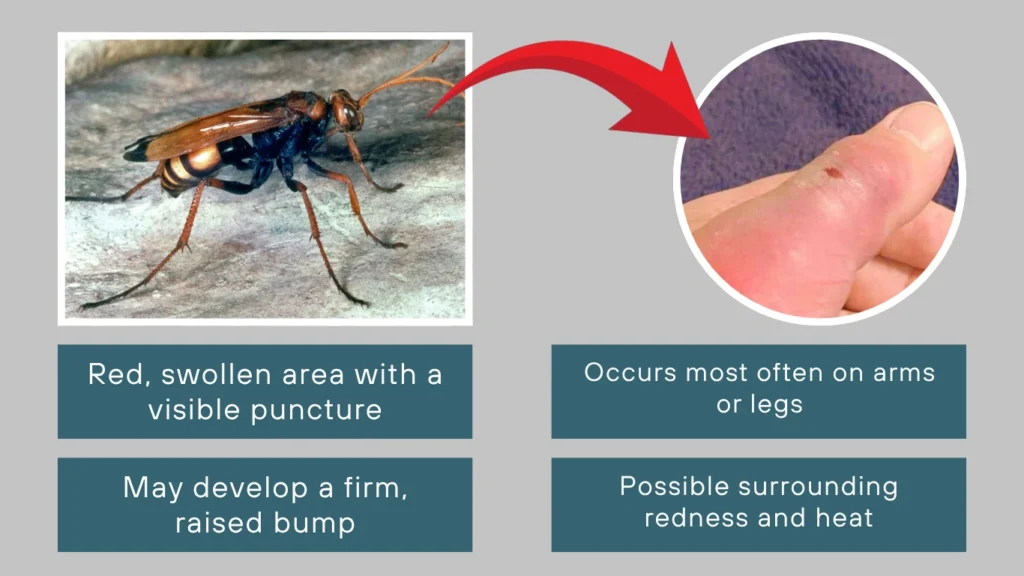
Spider wasps are solitary hunters known for paralyzing spiders to feed their larvae. Though not aggressive toward humans, they will sting if handled or trapped.
Identification of Sting
- Red, swollen area with a visible puncture
- May develop a firm, raised bump
- Occurs most often on arms or legs
- Possible surrounding redness and heat
- Rarely bruises unless scratched or irritated
Common Symptoms
The sting causes immediate, sharp pain followed by a burning sensation. Redness and mild swelling are typical. Some people report muscle soreness near the sting site, which can linger for hours.
Treatment Methods
Clean the area with antiseptic or soap and water. Apply an ice pack and use anti-inflammatory medication if needed. Antihistamines or hydrocortisone cream may relieve itching or swelling.
How Long It Lasts
Pain lasts for a few minutes to an hour. Swelling and tenderness may remain for 1–2 days depending on the individual’s sensitivity.
When to Seek Medical Help
Seek help if you experience spreading redness, fever, or symptoms of an allergic reaction such as difficulty breathing, hives, or swelling in distant areas.
FAQs
What should I do immediately after a wasp sting?
Clean the sting site with soap and water to prevent infection. Apply a cold compress to reduce swelling and pain. If needed, take over-the-counter pain relievers or antihistamines to manage symptoms.
How can I tell if I’m having an allergic reaction to a wasp sting?
Signs of an allergic reaction include difficulty breathing, swelling of the face or throat, rapid heartbeat, dizziness, and hives. These symptoms require immediate emergency medical attention.
Can wasps sting multiple times?
Yes, unlike bees, most wasps can sting multiple times because their stingers are not barbed. Species like yellow jackets and hornets are especially capable of repeated stings.
How long do wasp sting symptoms last?
Pain typically lasts a few hours, while redness, swelling, and itching may persist for 1–3 days. More severe reactions or multiple stings can prolong recovery time.
Are all wasp stings dangerous?
Most wasp stings are not dangerous and only cause temporary pain and swelling. However, stings from species like the tarantula hawk or warrior wasp can be extremely painful, and allergic reactions can be life-threatening in some individuals.
